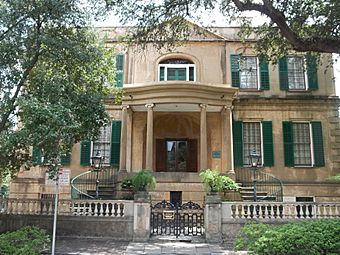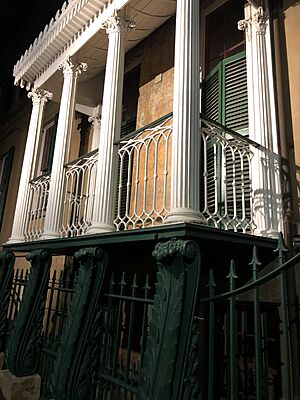Owens–Thomas House facts for kids
|
Owens–Thomas House
|
|

Owen–Thomas House in 2011
|
|
| Location | 124 Abercorn Street, Oglethorpe Square Savannah, Georgia |
|---|---|
| Built | 1819 |
| Architect | William Jay |
| Architectural style | Early Republic |
| Part of | Savannah Historic District (Savannah, Georgia) (ID66000277) |
| NRHP reference No. | 76000611 |
Quick facts for kids Significant dates |
|
| Added to NRHP | May 11, 1976 |
| Designated NHL | May 11, 1976 |
The Owens–Thomas House & Slave Quarters is a really old and important house in Savannah, Georgia. It's now a historic house museum run by Telfair Museums. You can find it at 124 Abercorn Street, right on the edge of Oglethorpe Square.
This house was named a National Historic Landmark in 1976. This means it's a very special place in American history. It's known as one of the best examples of English Regency architecture in the country.
In the 1990s, during some repairs, workers found something amazing. They uncovered and fixed up one of the oldest and best-kept urban slave quarters in the Southern United States.
Contents
A Look at the House's Design and History
This beautiful and important house was started in 1816 and finished in 1819. An English architect named William Jay designed it. He sent his plans from England before he even arrived in Savannah.
The house was built to look like the elegant buildings in Bath, England. You can see this in the special stone used and its detailed design. It was first called the Richardson House, after its first owner, Richard Richardson. It's a top example of English Regency architecture in North America.
In 1830, a local lawyer and politician, George Welshman Owens, bought the mansion. He paid $10,000 for it, which was a lot of money back then! His family owned the house for many years. Later, in 1951, Owens' granddaughter, Margaret Thomas, gave the house to the Telfair Academy of Arts and Sciences.
The house has a cool cast iron veranda on the side. It has fancy designs that look like leaves. A famous French general, the Marquis de Lafayette, even spoke to the people of Savannah from this veranda in 1825! William Jay also designed other famous buildings in Savannah, like the Scarborough house.
Exploring the Slave Quarters
A big part of visiting the Owens–Thomas House is learning about the people who were enslaved there. These were workers like the nanny, cook, and butler. They lived in the carriage house on the property.
During renovations in the 1990s, the owners found something very important. They discovered one of the oldest and best-preserved urban slave quarters in the American South. The museum has been working to share this history. They have a special "Slavery and Freedom Project." They also held events in 2008 and 2020 to discuss this history.
The ceiling of the slave quarters is painted a special color called "haint blue." People from the Gullah culture often used this color. They believed it would keep away ghosts or bad spirits. This ceiling is the largest area of "haint blue" paint found in North America!
The restoration also includes the pantry and other areas where meals were prepared. You can see the cellar where food was made and laundry was done.
The Museum Experience
The Owens–Thomas House museum has many beautiful items from the English Regency period. These include furniture and decorations from the Owens family. Most pieces date from the late 1700s to the mid-1800s.
You can see English and American furniture, old Savannah fabrics, silver, and Chinese porcelain. There's also art from the 18th and 19th centuries. In the slave quarters, you can see items that belonged to the enslaved people.
Outside, there's a lovely courtyard with a small garden. A landscape architect named Clermont Huger Lee redesigned it in 1954. She made it look like an English-American garden from the 1820s. She also helped take care of the garden for 14 years.
Gallery
See also
- List of National Historic Landmarks in Georgia (U.S. state)
- National Register of Historic Places listings in Chatham County, Georgia
- Jane Adair Wright, a person who helped preserve this house and was its curator




